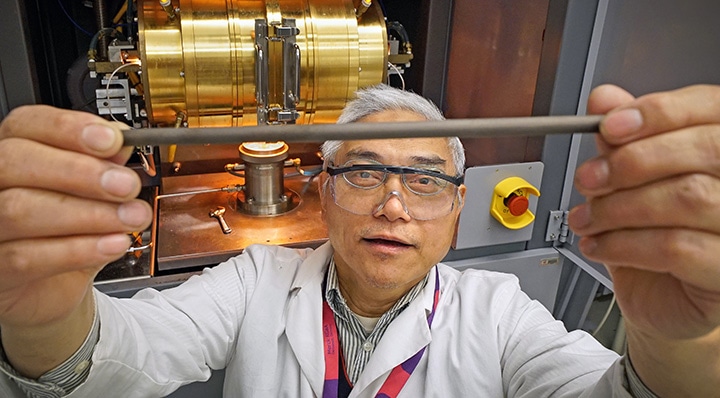Feb 19 2018
A concealed state of electronic order in a layered material possessing lanthanum, barium, copper, and oxygen (LBCO) has been detected by a team of researchers.
When cooled to a specific temperature and with particular concentrations of barium, LBCO is known to conduct electricity without resistance, but at the present, there is proof that a superconducting state truly occurs above this temperature too. It just required using the correct tool — in this case, high-intensity pulses of infrared light — to be able to detect it.
 Physicist Genda Gu holds a single-crystal rod of LBCO—a compound made of lanthanum, barium, copper, and oxygen—in Brookhaven's state-of-the-art crystal growth lab. The infrared image furnace he used to synthesize these high-quality crystals is pictured in the background. (Credit: BNL)
Physicist Genda Gu holds a single-crystal rod of LBCO—a compound made of lanthanum, barium, copper, and oxygen—in Brookhaven's state-of-the-art crystal growth lab. The infrared image furnace he used to synthesize these high-quality crystals is pictured in the background. (Credit: BNL)
The team’s discovery provides additional understanding into the decades-long mystery of superconductivity in LBCO and similar compounds possessing copper and oxygen layers sandwiched between other elements. These “cuprates” become superconducting at comparatively higher temperatures than traditional superconductors, which must be frozen to near absolute zero (-459 °F) before their electrons can pass through them at 100 percent efficiency. Comprehending why cuprates act the way they do could help researchers design better high-temperature superconductors, eliminating the cost of costly cooling systems and enhancing the efficiency of power generation, transmission, and distribution. Visualize computers that never heat up and power grids that do not lose energy on any account. Their findings have been published in the February 2nd issue of Science.
“The ultimate goal is to achieve superconductivity at room temperature,” said John Tranquada, a physicist and leader of the Neutron Scatter Group in the Condensed Matter Physics and Materials Science Department at the U.S. Department of Energy’s (DOE) Brookhaven National Laboratory, where he has been studying cuprates since the 1980s.
If we want to do that by design, we have to figure out which features are essential for superconductivity. Teasing out those features in such complicated materials as the cuprates is no easy task.
John Tranquada
The copper-oxygen planes of LBCO have “stripes” of electrical charge divided by a type of magnetism in which the electron spins alternate in opposite directions. In order for LBCO to become superconducting, the individual electrons in these stripes have to be able to pair up and move in harmony throughout the material.
Earlier experiments revealed that, above the temperature at which LBCO becomes superconducting, resistance takes place when the electrical transport is perpendicular to the planes but is zero when the transport is parallel. Theorists projected that this phenomenon might be the consequence of an abnormal spatial modulation of the superconductivity, with the amplitude of the superconducting state oscillating from positive to negative on traveling from one charge stripe to the next. The stripe pattern rotates by 90 degrees from layer to layer, and they thought that this relative orientation was hindering the superconducting electron pairs from traveling coherently between the layers.
This idea is similar to passing light through a pair of optical polarizers, such as the lenses of certain sunglasses. When the polarizers have the same orientation, they pass light, but when their relative orientation is rotated to 90 degrees, they block all light.
John Tranquada
However, a direct experimental test of this picture had been missing — until now.
One of the difficulties is synthesizing the large, superior-quality single crystals of LBCO required to conduct experiments. “It takes two months to grow one crystal, and the process requires precise control over temperature, atmosphere, chemical composition, and other conditions,” said co-author Genda Gu, a physicist in Tranquada’s group. Gu used an infrared image furnace — a machine having two bright lamps that focus infrared light onto a cylindrical rod containing the starting material, heating it to almost 2500 °F and making it melt — in his crystal growth lab to grow the LBCO crystals.
Collaborators at the Max Planck Institute for the Structure and Dynamics of Matter and the University of Oxford then directed infrared light, produced from high-intensity laser pulses, at the crystals (with the light polarization in a direction perpendicular to the planes) and measured the intensity of light reflected back from the sample. In addition to the usual response—the crystals reflected the same frequency of light that was conveyed in—the researchers detected a signal three times higher than the frequency of that incident light.
“For samples with three-dimensional superconductivity, the superconducting signature can be seen at both the fundamental frequency and at the third harmonic,” said Tranquada. “For a sample in which charge stripes block the superconducting current between layers, there is no optical signature at the fundamental frequency. However, by driving the system out of equilibrium with the intense infrared light, the scientists induced a net coupling between the layers, and the superconducting signature shows up in the third harmonic. We had suspected that the electron pairing was present—it just required a stronger tool to bring this superconductivity to light.”
University of Hamburg theorists assisted this experimental observation with analysis and numerical simulations of the reflectivity.
This study offers a new method to investigate various types of electronic orders in high-temperature superconductors, and the new understanding may be supportive in explaining other odd behaviors in the cuprates.
The research done at Brookhaven was supported by DOE’s Office of Science.